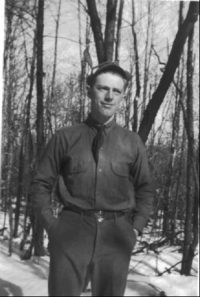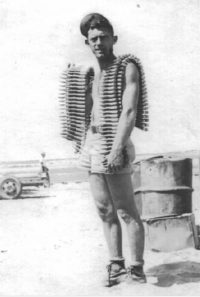Harold E. Stahl
Armorer Harold E. Stahl’s journey to the war, by his son Glenn Stahl

Harold graduated from high school in May 1935. The country was still deep in the depression and jobs were scarce. So, he joined the Civilian Conservation Corps on July 19, 1935 (age 18) and worked at CCC camp #7 in Kane, Pennsylvania until September 30, 1937. This camp focused its efforts on forestry work, so Harold surveyed, timbered and built fire breaks through the back woods of northern Pennsylvania.
Workers in the CCC were paid $30 per month and had $25 of that sent directly to their families to provide economic relief during the depression.
Upon his return from the CCC in September 1937 (age 20), he enjoyed a typical life of a 20-year-old hanging out with his friends, fishing, swimming, cars, motorcycles, dancing and dating.
It was during a date that Harold’s life took a major detour. It was December 7, 1941 and on his car radio they heard about the Japanese attack on Pearl Harbor. He enlisted in the Army Air Corps on January 12, 1942. He went to basic training and then graduated from the Air Corps Technical School at Chanute Field, Illinois on July 28, 1942 having been trained in airplane mechanics.
Harold was assigned to the Eighty-Fifth Fighter Squadron (“The Flying Skulls”) of the 79th Fighter Group. He subsequently shipped out of Norfolk, Virginia on October 7, 1942 – destination unknown. The troop ship sailed along the coast to South America and around the tip of South Africa to avoid German submarines, which were roaming the north Atlantic. On November 12, 1942, after 37 days at sea, he eventually ended up in Egypt, where the 79th was assigned to provide air support to the British Eighth Army under General Montgomery.
Despite being trained in aircraft mechanics, Harold ended up in armament. With his photography experience, he also processed combat photographs and motion pictures taken by automatic cameras synchronized with the machine guns on the fighter planes to document hits.
Upon arriving in Egypt, supplies were scarce and conditions were poor. They ate British Army emergency rations for the first 5 days. He remembered eating wormy biscuits till supplies caught up to them. The desert sandstorms tormented man and machine as they crossed North Africa. Harold contracted malaria soon after landing in Suez and was treated in a hospital before catching up with his unit in the desert.
During the evening of January 13, 1943, Harold was on guard duty and challenged an intruder. The response was a hail of bullets from Arabs attempting to steal supplies. One bullet passed through his knee, fortunately leaving no permanent damage. However, bullet holes through the visor of his hat showed how close he came to more serious injury or death. Since the injury was not the result of enemy combatants (the Arabs were technically our allies), he did not receive a Purple Heart for his injury.
After recovering in a hospital in Alexandria, Egypt, he was flown back to his squadron near the front.

At the end of hostilities in Europe, the 79th was being readied to ship off to the Pacific theater. Luckily, that conflict ended before they shipped out and Harold returned home to Pennsylvania, being honorably discharged from the Air Corps on August 26th, 1945. He had been continuously away from home just 42 days short of 3 years.
